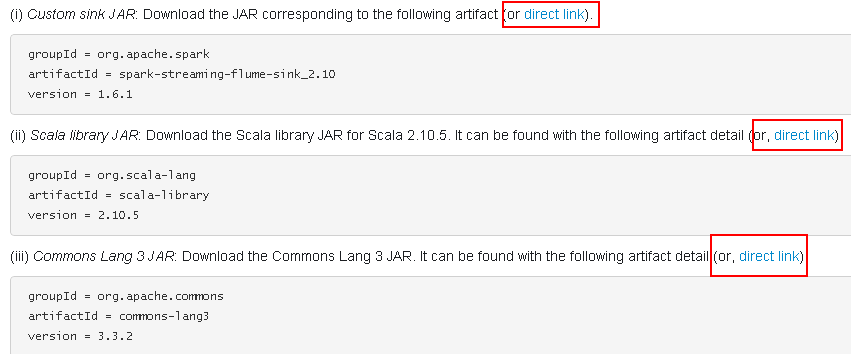本節課分成二部分講解:
一、Spark Streaming on Pulling from Flume實戰
二、Spark Streaming on Pulling from Flume源碼解析
先簡單介紹下Flume的兩種模式:推模式(Flume push to Spark Streaming)和 拉模式(Spark Streaming pull from Flume )
採用推模式:推模式的理解就是Flume作爲緩存,存有數據。監聽對應端口,如果服務可以連接,就將數據push過去。(簡單,耦合要低),缺點是Spark Streaming程序沒有啓動的話,Flume端會報錯,同時會導致Spark Streaming程序來不及消費的情況。
採用拉模式:拉模式就是自己定義一個sink,Spark Streaming自己去channel裏面取數據,根據自身條件去獲取數據,穩定性好。
Flume pull實戰:
第一步:安裝Flume,本節課不在說明,參考(第87課:Flume推送數據到SparkStreaming案例實戰和內幕源碼解密)
第二步:配置Flume,首先參照官網(http://spark.apache.org/docs/latest/streaming-flume-integration.html)要求添加依賴或直接下載3個jar包,並將其放入Flume安裝目錄下的lib目錄中
spark-streaming-flume-sink_2.10-1.6.0.jar、scala-library-2.10.5.jar、commons-lang3-3.3.2.jar
第三步:配置Flume環境參數,修改flume-conf.properties,從flume-conf.properties.template複製一份進行修改
#Flume pull模式
agent0.sources = source1
agent0.channels = memoryChannel
agent0.sinks = sink1
#配置Source1
agent0.sources.source1.type = spooldir
agent0.sources.source1.spoolDir = /home/hadoop/flume/tmp/TestDir
agent0.sources.source1.channels = memoryChannel
agent0.sources.source1.fileHeader = false
agent0.sources.source1.interceptors = il
agent0.sources.source1.interceptors.il.type = timestamp
#配置Sink1
agent0.sinks.sink1.type = org.apache.spark.streaming.flume.sink.SparkSink
agent0.sinks.sink1.hostname = SparkMaster
agent0.sinks.sink1.port = 9999
agent0.sinks.sink1.channel = memoryChannel
#配置channel
agent0.channels.memoryChannel.type = file
agent0.channels.memoryChannel.checkpointDir = /home/hadoop/flume/tmp/checkpoint
agent0.channels.memoryChannel.dataDirs = /home/hadoop/flume/tmp/dataDir
啓動flume命令:
root@SparkMaster:~/flume/flume-1.6.0/bin# ./flume-ng agent --conf ../conf/ --conf-file ../conf/flume-conf.properties --name agent0 -Dflume.root.logger=INFO,console
或者root@SparkMaster:~/flume/flume-1.6.0# flume-ng agent --conf ./conf/ --conf-file ./conf/flume-conf.properties --name agent0 -Dflume.root.logger=INFO,console
第四步:編寫簡單的業務代碼(Java版)
package com.dt.spark.SparkApps.sparkstreaming;
import java.util.Arrays;
import org.apache.spark.SparkConf;
import org.apache.spark.api.java.function.FlatMapFunction;
import org.apache.spark.api.java.function.Function2;
import org.apache.spark.api.java.function.PairFunction;
import org.apache.spark.streaming.Durations;
import org.apache.spark.streaming.api.java.JavaDStream;
import org.apache.spark.streaming.api.java.JavaPairDStream;
import org.apache.spark.streaming.api.java.JavaReceiverInputDStream;
import org.apache.spark.streaming.api.java.JavaStreamingContext;
import org.apache.spark.streaming.flume.FlumeUtils;
import org.apache.spark.streaming.flume.SparkFlumeEvent;
import scala.Tuple2;
public class SparkStreamingPullDataFromFlume {
public static void main(String[] args) {
SparkConf conf = new SparkConf().setMaster("spark://SparkMaster:7077");
conf.setAppName("SparkStreamingPullDataFromFlume");
JavaStreamingContext jsc = new JavaStreamingContext(conf, Durations.seconds(30));
// 獲取數據
JavaReceiverInputDStream lines = FlumeUtils.createPollingStream(jsc, "SparkMaster", 9999);
// 進行單詞切分
JavaDStream<String> words = lines.flatMap(new FlatMapFunction<SparkFlumeEvent, String>() {
public Iterable<String> call(SparkFlumeEvent event) throws Exception {
String line = new String(event.event().getBody().toString());
return Arrays.asList(line.split(" "));
}
});
// 進行map操作,轉換成(key,value)格式
JavaPairDStream<String, Integer> pairs = words.mapToPair(new PairFunction<String, String, Integer>() {
public Tuple2<String, Integer> call(String word) throws Exception {
return new Tuple2<String, Integer>(word, 1);
}
});
// 進行reduceByKey動作,將key相同的value值進行合併
JavaPairDStream<String, Integer> wordsCount = pairs.reduceByKey(new Function2<Integer, Integer, Integer>() {
public Integer call(Integer v1, Integer v2) throws Exception {
return v1 + v2;
}
});
wordsCount.print();
jsc.start();
jsc.awaitTermination();
jsc.close();
}
}
將程序打包成jar文件上傳到Spark集羣中
第五步:啓動HDFS、Spark集羣和Flume
啓動Flume:root@SparkMaster:~/flume/flume-1.6.0/bin# ./flume-ng agent --conf ../conf/ --conf-file ../conf/flume-conf.properties --name agent0 -Dflume.root.logger=INFO,console
第六步:往/home/hadoop/flume/tmp/TestDir目錄中上傳測試文件,查看Flume的日誌變化
第七步:通過spark-submit命令運行程序:
./spark-submit --class com.dt.spark.SparkApps.SparkStreamingPullDataFromFlume --name SparkStreamingPullDataFromFlume /home/hadoop/spark/SparkStreamingPullDataFromFlume.jar
每隔30秒查看運行結果
第二部分:源碼分析
1、創建createPollingStream (FlumeUtils.scala )
注意:默認的存儲方式是MEMORY_AND_DISK_SER_2
/**
* Creates an input stream that is to be used with the Spark Sink deployed on a Flume agent.
* This stream will poll the sink for data and will pull events as they are available.
* This stream will use a batch size of 1000 events and run 5 threads to pull data.
* @param hostname Address of the host on which the Spark Sink is running
* @param port Port of the host at which the Spark Sink is listening
* @param storageLevel Storage level to use for storing the received objects
*/
def createPollingStream(
ssc: StreamingContext,
hostname: String,
port: Int,
storageLevel: StorageLevel = StorageLevel.MEMORY_AND_DISK_SER_2
): ReceiverInputDStream[SparkFlumeEvent] = {
createPollingStream(ssc, Seq(new InetSocketAddress(hostname, port)), storageLevel)
}
2、參數配置:默認的全局參數,private 級別配置無法修改
private val DEFAULT_POLLING_PARALLELISM = 5
private val DEFAULT_POLLING_BATCH_SIZE = 1000
/**
* Creates an input stream that is to be used with the Spark Sink deployed on a Flume agent.
* This stream will poll the sink for data and will pull events as they are available.
* This stream will use a batch size of 1000 events and run 5 threads to pull data.
* @param addresses List of InetSocketAddresses representing the hosts to connect to.
* @param storageLevel Storage level to use for storing the received objects
*/
def createPollingStream(
ssc: StreamingContext,
addresses: Seq[InetSocketAddress],
storageLevel: StorageLevel
): ReceiverInputDStream[SparkFlumeEvent] = {
createPollingStream(ssc, addresses, storageLevel,
DEFAULT_POLLING_BATCH_SIZE, DEFAULT_POLLING_PARALLELISM)
}
3、創建FlumePollingInputDstream對象
/**
* Creates an input stream that is to be used with the Spark Sink deployed on a Flume agent.
* This stream will poll the sink for data and will pull events as they are available.
* @param addresses List of InetSocketAddresses representing the hosts to connect to.
* @param maxBatchSize Maximum number of events to be pulled from the Spark sink in a
* single RPC call
* @param parallelism Number of concurrent requests this stream should send to the sink. Note
* that having a higher number of requests concurrently being pulled will
* result in this stream using more threads
* @param storageLevel Storage level to use for storing the received objects
*/
def createPollingStream(
ssc: StreamingContext,
addresses: Seq[InetSocketAddress],
storageLevel: StorageLevel,
maxBatchSize: Int,
parallelism: Int
): ReceiverInputDStream[SparkFlumeEvent] = {
new FlumePollingInputDStream[SparkFlumeEvent](ssc, addresses, maxBatchSize,
parallelism, storageLevel)
}
4、繼承自ReceiverInputDstream並覆寫getReciver方法,調用FlumePollingReciver接口
private[streaming] class FlumePollingInputDStream[T: ClassTag](
_ssc: StreamingContext,
val addresses: Seq[InetSocketAddress],
val maxBatchSize: Int,
val parallelism: Int,
storageLevel: StorageLevel
) extends ReceiverInputDStream[SparkFlumeEvent](_ssc) {
override def getReceiver(): Receiver[SparkFlumeEvent] = {
new FlumePollingReceiver(addresses, maxBatchSize, parallelism, storageLevel)
}
}
5、ReceiverInputDstream 構建了一個線程池,設置爲後臺線程;並使用lazy和工廠方法創建線程和NioClientSocket(NioClientSocket底層使用NettyServer的方式)
lazy val channelFactoryExecutor =
Executors.newCachedThreadPool(new ThreadFactoryBuilder().setDaemon(true).
setNameFormat("Flume Receiver Channel Thread - %d").build())
lazy val channelFactory =
new NioClientSocketChannelFactory(channelFactoryExecutor, channelFactoryExecutor)
6、receiverExecutor 內部也是線程池;connections是指鏈接分佈式Flume集羣的FlumeConnection實體句柄的個數,線程拿到實體句柄訪問數據。
lazy val receiverExecutor = Executors.newFixedThreadPool(parallelism,
new ThreadFactoryBuilder().setDaemon(true).setNameFormat("Flume Receiver Thread - %d").build())
private lazy val connections = new LinkedBlockingQueue[FlumeConnection]()
7、啓動時創建NettyTransceiver,根據並行度(默認5個)循環提交FlumeBatchFetcher
override def onStart(): Unit = {
// Create the connections to each Flume agent.
addresses.foreach(host => {
val transceiver = new NettyTransceiver(host, channelFactory)
val client = SpecificRequestor.getClient(classOf[SparkFlumeProtocol.Callback], transceiver)
connections.add(new FlumeConnection(transceiver, client))
})
for (i <- 0 until parallelism) {
logInfo("Starting Flume Polling Receiver worker threads..")
// Threads that pull data from Flume.
receiverExecutor.submit(new FlumeBatchFetcher(this))
}
}
8、FlumeBatchFetcher run方法中從Receiver中獲取connection鏈接句柄ack跟消息確認有關
def run(): Unit = {
while (!receiver.isStopped()) {
val connection = receiver.getConnections.poll()
val client = connection.client
var batchReceived = false
var seq: CharSequence = null
try {
getBatch(client) match {
case Some(eventBatch) =>
batchReceived = true
seq = eventBatch.getSequenceNumber
val events = toSparkFlumeEvents(eventBatch.getEvents)
if (store(events)) {
sendAck(client, seq)
} else {
sendNack(batchReceived, client, seq)
}
case None =>
}
} catch {
9、獲取一批一批數據方法
/**
* Gets a batch of events from the specified client. This method does not handle any exceptions
* which will be propogated to the caller.
* @param client Client to get events from
* @return [[Some]] which contains the event batch if Flume sent any events back, else [[None]]
*/
private def getBatch(client: SparkFlumeProtocol.Callback): Option[EventBatch] = {
val eventBatch = client.getEventBatch(receiver.getMaxBatchSize)
if (!SparkSinkUtils.isErrorBatch(eventBatch)) {
// No error, proceed with processing data
logDebug(s"Received batch of ${eventBatch.getEvents.size} events with sequence " +
s"number: ${eventBatch.getSequenceNumber}")
Some(eventBatch)
} else {
logWarning("Did not receive events from Flume agent due to error on the Flume agent: " +
eventBatch.getErrorMsg)
None
}
}
備註:
資料來源於:DT_大數據夢工廠
更多私密內容,請關注微信公衆號:DT_Spark
如果您對大數據Spark感興趣,可以免費聽由王家林老師每天晚上20:00開設的Spark永久免費公開課,地址YY房間號:68917580

